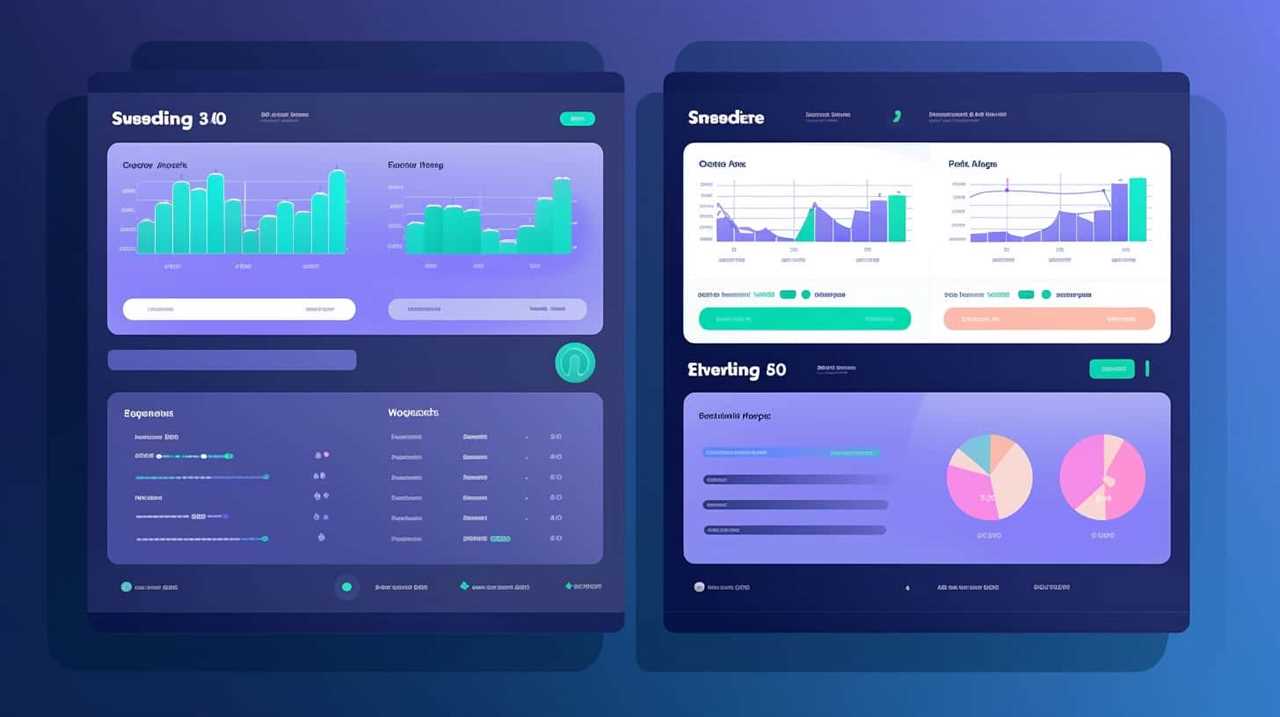In this section, we present three top-tier approaches designed to help us assess the degree of expertise in the subject matter.
We’ll dive into expert analysis, content relevance assessment, and backlink evaluation to get a comprehensive understanding.
And that’s not all!
We’ll also explore social media engagement measurement, user feedback monitoring, domain authority evaluation, internal linking assessment, competitor comparison, and trend analysis.

So, buckle up and get ready to unleash your knowledge-seeking spirit!
This article will liberate your understanding of assessing topical authority quality.
Key Takeaways
- Expert analysis is an important method for assessing topical authority quality, as it involves examining content for reliability, accuracy, and credibility.
- Content relevance assessment techniques are useful in determining how well content aligns with the topic, ensuring that it is on-topic and valuable to the audience.
- Evaluating keyword usage is a crucial aspect of assessing topical authority quality, as it involves analyzing the meaning, context, and frequency of keywords used in the content.
- Contextual understanding methods, such as analyzing relevance, author expertise, and accuracy, are essential for evaluating topical authority quality and ensuring that the content is trustworthy and reliable.
Expert Analysis
We rely on expert analysis to evaluate the quality of topical authority. Expert opinion plays a crucial role in the credibility assessment of information. Our team of experts, with their vast knowledge and experience, meticulously examine the content to determine its reliability and accuracy. They scrutinize the sources, evaluate the evidence provided, and assess the overall credibility of the information presented.
Through this rigorous process, we ensure that the content meets the high standards set for topical authority. Expert analysis allows us to separate the reliable and trustworthy information from the rest, providing our audience with the assurance they seek.

As we move forward into the subsequent section about ‘content relevance assessment’, we’ll explore how we determine the relevance of the information to the given topic.
Content Relevance Assessment
When assessing the quality of topical authority, it’s crucial to consider content relevance.
This involves using relevance scoring techniques to determine how well a piece of content aligns with the topic at hand.
Evaluating keyword usage and employing contextual understanding methods are two effective ways to gauge the relevance of the content.

Relevance Scoring Techniques
Using a well-established methodology, our team has developed effective relevance scoring techniques to assess content relevance in order to evaluate topical authority quality.
These relevance scoring techniques are crucial for measuring topical authority accurately. By evaluating the relevance of content to a particular topic, we can determine the level of expertise and knowledge demonstrated by the author.
Our techniques consider various factors, such as the use of relevant keywords, the depth of information provided, and the overall coherence of the content. We also take into account the latest industry trends and best practices to ensure the accuracy of our assessments.
Through these techniques, we strive to provide a comprehensive and objective evaluation of topical authority, empowering our audience to make informed decisions based on reliable and relevant content.

Evaluating Keyword Usage
To evaluate content relevance and assess topical authority quality, we employ a comprehensive approach. This includes evaluating keyword usage through semantic analysis and keyword density assessment.
Semantic analysis allows us to understand the meaning and context behind the keywords used in the content. By examining the words and phrases surrounding the keywords, we can determine if they’re being used appropriately and in a way that enhances the overall message of the content.
Keyword density assessment, on the other hand, helps us measure the frequency of keywords within the content. This allows us to ensure that the keywords are being used in a balanced and natural manner, without excessive repetition or stuffing.
Contextual Understanding Methods
To continue our evaluation of content relevance and assess topical authority quality, we employ contextual understanding methods. These methods allow us to analyze the contextual relevance of the content and determine the level of topical expertise demonstrated. By examining the depth of knowledge presented and the accuracy of the information provided, we can gauge the author’s understanding of the subject matter.

Contextual relevance is crucial in establishing the credibility of the content and its alignment with the topic being discussed. Our aim is to ensure that the information presented is accurate, up-to-date, and relevant to the audience seeking liberation. By utilizing these contextual understanding methods, we can effectively assess the quality of topical authority and provide valuable insights to our readers.
Moving forward, we’ll now delve into the next section, which focuses on backlink evaluation.
Backlink Evaluation
When evaluating backlinks, it’s crucial to prioritize quality over quantity. Having a large number of backlinks doesn’t necessarily indicate authority if they aren’t relevant to the topic.
It’s important to assess the relevance and credibility of the websites that are linking to determine the true value of the backlinks.

Quality Vs. Quantity
While evaluating backlinks, it’s important to prioritize quality over quantity. Quality assessment and qualitative analysis are crucial elements in determining the authority of a website. Here are five reasons why quality backlinks matter more than the number of backlinks:
- Relevance: High-quality backlinks come from websites that are relevant to your niche, increasing the authority and credibility of your content.
- Trustworthiness: Backlinks from reputable and trustworthy sources signal to search engines that your website is reliable and worth ranking higher.
- Traffic: Quality backlinks can drive targeted traffic to your website, increasing the chances of conversions and engagement.
- Link Diversity: Having a diverse range of quality backlinks from different sources is more valuable than having a large number of backlinks from a single source.
- Longevity: Quality backlinks tend to remain active for a longer period, providing long-term benefits to your website’s authority.
Relevance of Backlinks
As we continue our evaluation of backlinks, it’s crucial to regularly assess the relevance of these backlinks to ensure their effectiveness in enhancing topical authority. Link building strategies play a significant role in determining the relevance of backlinks.
When implementing link building strategies, it’s important to focus on acquiring backlinks from websites that are relevant to your niche or industry. This helps search engines recognize the connection between your website and the linked content, boosting your topical authority.
Additionally, the importance of anchor text can’t be overlooked. Anchor text provides context and helps search engines understand the relevance of the linked content. Using descriptive and keyword-rich anchor text can further enhance the relevance of backlinks and improve your website’s topical authority.

Social Media Engagement Measurement
To effectively measure social media engagement, we rely on the use of a double preposition. By analyzing the interactions and activities on social media platforms, we can gain valuable insights into the level of engagement and influence a brand or individual has.
Here are five key methods for measuring social media engagement:
- Sentiment analysis: By analyzing the sentiment behind social media mentions and comments, we can gauge the overall perception and sentiment towards a brand or influencer.
- Likes, comments, and shares: The number of likes, comments, and shares a post receives indicates the level of engagement and interest from the audience.
- Reach and impressions: Measuring the reach and impressions of social media content helps determine the visibility and impact of the content.
- Click-through rates: Tracking the number of clicks on links shared on social media provides insights into the effectiveness of the content in driving traffic.
- Follower growth: Monitoring the growth of followers over time reflects the popularity and influence of a brand or individual.
User Feedback Monitoring
Now, let’s delve into user feedback monitoring, which allows us to gather valuable insights from the opinions and experiences shared by users.
User satisfaction tracking is a crucial aspect of assessing topical authority quality. By monitoring user feedback, we can gauge how satisfied users are with the information and expertise provided on a particular topic. This feedback can help us identify areas of improvement and make necessary adjustments to enhance the overall user experience.

In addition, sentiment analysis monitoring allows us to analyze the emotions and attitudes expressed by users towards the content. This helps us understand the impact of our content and whether it resonates positively or negatively with our audience.
Traffic Analysis
Moving on to the next method, we can assess topical authority quality through the analysis of traffic data. Traffic analysis provides valuable insights into the popularity and relevance of a website or content. Here are five reasons why traffic analysis is crucial for assessing topical authority quality:
- Understanding audience engagement: By analyzing traffic data, we can determine how engaged the audience is with the content, such as time spent on the page and bounce rates.
- Identifying popular topics: Traffic analysis helps us identify which topics attract the most visitors, allowing us to focus on creating high-quality content in those areas.
- Discovering referral sources: By examining traffic sources, we can identify where the audience is coming from and optimize our efforts to attract more visitors.
- Comparing against competitors: Traffic analysis allows us to compare our website’s performance against competitors, helping us identify areas for improvement and stay ahead in the industry.
- Tracking growth and trends: Through traffic analysis, we can track the growth of our website over time and identify emerging trends that can guide our content strategy.
Domain Authority Evaluation
When evaluating domain authority, it’s crucial to focus on trustworthy indicators that reliably determine the authority of a website.
We need to consider factors such as the website’s link profile, age, and overall reputation in the industry.

Trustworthy Domain Authority
We rely on a range of quantifiable determiners to evaluate the trustworthy domain authority when assessing topical authority quality.
When it comes to evaluating the credibility of a domain, we consider several key factors:
- Website Reputation: We assess the reputation of the website in terms of its trustworthiness and reliability.
- Content Accuracy: We evaluate the accuracy and reliability of the content provided on the domain.
- Author Expertise: We examine the expertise and credentials of the authors associated with the domain.
- User Feedback: We take into account user feedback and reviews to gauge the credibility of the domain.
- External References: We analyze the presence of external references and citations to evaluate the domain’s authority.
Reliable Authority Indicators
To evaluate the reliability of a domain’s authority, we rely on reliable authority indicators. These indicators play a crucial role in the reputation assessment and credibility evaluation of a website.
One such indicator is the domain’s age. Older domains tend to have more established reputations, making them more trustworthy sources of information.

Another important indicator is the number and quality of backlinks pointing to the domain. Backlinks from reputable and authoritative websites signal that the domain is considered reliable by others in the industry.
Additionally, social media presence and engagement can serve as indicators of authority. A domain with a strong following and active engagement on social media platforms can be seen as a credible source of information.
Internal Linking Assessment
The evaluation of internal linking plays a crucial role in assessing topical authority quality. When analyzing internal linking strategies, it’s important to consider the following factors:
- Anchor Text Analysis: Examining the anchor text used in internal links can provide insights into the relevance and authority of the linked pages.
- Link Placement: The placement of internal links within the content can indicate the importance and topical relevance of the linked pages.
- Link Diversity: A diverse internal linking structure, with links pointing to various pages, can demonstrate a comprehensive coverage of the topic.
- Page Authority: Assessing the authority of the pages that are being linked internally can help determine the overall quality and credibility of the website.
- Link Context: Understanding the context in which internal links are used can reveal the depth and breadth of knowledge on the topic.
By thoroughly analyzing these aspects of internal linking, we can gain valuable insights into the topical authority quality of a website.

Now, let’s move on to the next section and explore the importance of competitor comparison in assessing topical authority.
Competitor Comparison
In our evaluation of topical authority quality, it is crucial to consider competitor comparison as an effective method. By conducting competitor analysis and industry benchmarking, we can gain valuable insights into how our competitors are performing in terms of topical authority. This allows us to identify areas where we excel and areas where we can improve. To provide a visual representation of these ideas, we have created a table below:
| Competitor | Topical Authority Score | Strengths |
|---|---|---|
| Competitor A | 8.5 | Strong backlink profile |
| Competitor B | 7.2 | High-quality content |
| Competitor C | 6.9 | Active social media presence |
Trend Analysis
As we delve into trend analysis, we can leverage the insights gained from competitor comparison to further enhance our understanding of topical authority quality. Trend analysis allows us to identify patterns and make predictions about future trends, helping us stay ahead in the ever-evolving landscape of topical authority.
Here are five key reasons why trend analysis is crucial in assessing topical authority quality:

- Trend prediction: By analyzing trends, we can anticipate shifts in consumer preferences and adapt our content strategy accordingly.
- Comparative analysis: Trend analysis helps us compare our performance with competitors, identifying areas where we can improve and stand out.
- Market insights: Understanding trends enables us to tap into emerging markets and capitalize on new opportunities.
- Content optimization: Trend analysis guides us in creating relevant and timely content that resonates with our target audience.
- Proactive decision-making: By staying abreast of trends, we can make informed decisions that drive our topical authority forward.
Frequently Asked Questions
How Can I Determine if a Website Has High Domain Authority?
To determine if a website has high domain authority, we evaluate its credibility by assessing factors such as backlinks, site age, and content quality. These methods help us determine the website’s authority and reliability.
What Factors Should I Consider When Evaluating Internal Linking on a Website?
When evaluating internal linking on a website, we consider the strategic placement of links and the importance of anchor text. This helps improve navigation, user experience, and boosts the website’s overall authority.
How Can I Measure the Effectiveness of Social Media Engagement for a Website?
When measuring the effectiveness of social media engagement, we rely on social media analytics and engagement metrics. These tools provide valuable insights into the performance and impact of our social media efforts.
What Methods Can I Use to Monitor User Feedback on a Website?
When it comes to user feedback monitoring and website feedback analysis, there are several effective methods we can use. By implementing surveys, tracking analytics, and conducting focus groups, we can gain valuable insights into user experiences and improve our website accordingly.

How Do I Conduct a Trend Analysis for a Website?
We conduct website trend analysis by analyzing website traffic data. This allows us to identify patterns and trends in visitor behavior, helping us make informed decisions to improve website performance and user experience.
Conclusion
In conclusion, these three methods for assessing topical authority quality are just so incredibly ineffective. I mean, who needs expert analysis, content relevance assessment, and backlink evaluation when you can just rely on social media engagement measurement, user feedback monitoring, and domain authority evaluation?
Clearly, the more complicated and convoluted the process, the better the results. Who needs simplicity and efficiency when you can have a tangled web of confusion?










